3 G reat G arde N s to visit
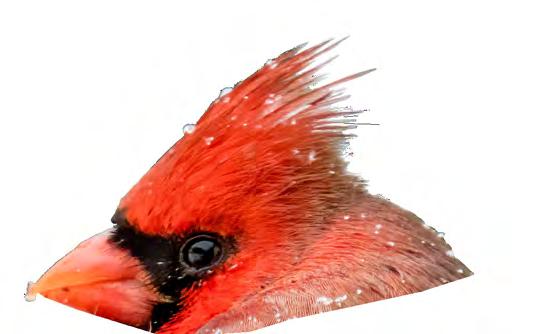

New Polli N ator Garde N | Holiday d ri N ks | For t H e Birds Winter 22/23 • Vol 51


Donate online or call 416-397-1483 torontobotanicalgarden.ca/hearts SUPPORT THE GARDEN YOU LOVE
[4] FROM THE TBG celebrate the year’s success
[5] HEARTS AND FLOWERS CAMPAIGN generous donors keep the garden growing
[6] WINTER INTEREST books in the Weston Family library
[8] CONNECTING WITH NATURE Pollinatorto grant put to good use
[12] SMASHING COLOUR trial garden continues to attract visitors
[14] FAKE GRASS
is it good or bad for your garden?
[18] FIRST NATIONS
GARDEN connecting with the past at Montreal botanical garden
[26] VALLARTA
BOTANICAL GARDEN a blissful escape from usual tourist hangouts
[28] GIVERNY as close to magic as you can get
[34] FOR THE BIRDS
Stay connected to the garden when most plants are asleep
[36] BOOK SHELF
the complete book of ground covers
[38] DIY
three festive drinks to toast the season

[40] PUZZLE PIECES challenges for patient puzzlers
[41] TRIBUTE TO VOLUNTEERS
[42] OUR TEAM IS GROWING
Welcome new tbg staff members
[44] GOOD THINGS ARE HAPPENING
[48] PLANT PROFILE
Philodendron—a tale of two beauties
torontobotanicalgarden.ca 3 Winter 2022-2023
c o ver P hoto: n orthern cardinal in W inter: Pexel S inside Winter 2022 • Vol 51
Festive drinks to toast the season. Page 38
Over the past few weeks, recollections of being introduced to the Toronto Botanical Garden have washed over me. As in most matchmakings, the process was a steady set of conversations over several months. And with each conversation my interest in the TBG increased, and so did my commitment to help the Garden achieve its dreams and embrace the next chapter of growth. By the time I learned I was the finalist, and had a job offer, I was all-in—ready to listen deeply, dream boldly, lead diligently and build strategically.
Stepping into the role of Executive Director in January 2022, I was embarking in an interesting time and way to start a new job. Following 23 months of lock down in Ontario with a lot of unknowns for what our next normal would look like, I was determined to bring new energy and confidence to define the path forward. And here we are, at the end of the calendar year, having achieved so much. The Visitor Centre reopened, the Education Programs returned in-person, the Spring Plant Sale and Edwards Summer Music Series re-emerged, the Garden received deep pruning and the addition of new pollinator-friendly plants in the Perennial Borders and so much more. Our volunteers returned, our staff grew (in number and capacity) and you—our loyal supporters—continued to show up to the place that you love so deeply. It has been a great joy for the TBG team to relaunch so much of what had been paused, create new opportunities and welcome you back.
Winter Activities While the gardening season has wound down, we have lots to keep you engaged through the colder months. November 25 to 27 the Holiday Market will
return, bringing a great reason to spend time at the Garden, supporting the organization through your holiday gift buying and being together in community. I look forward to seeing you there, connecting and celebrating this festive season.
New in 2022, we launched the TBG Author Series, featuring local authors. (See more on page 45.) We have two upcoming talks including Reimagining Toronto’s Ravines with Alissa North on November 16 and Mushrooming, The Joy of the Quiet Hunt – An Illustrated Guide to the Fascinating, the Delicious, the Deadly and the Strange with Diane Borsato on December 1.
With the turn of the calendar, we will launch a new Winter Music Series, bringing the spirit of the Edwards Summer Music Series into the building—a great reason to visit from February to April. The 2023 season will feature Tafelmusik, a Toronto-based orchestra and choir that brings new energy to baroque music and beyond, using period instruments.
And, I am pleased to report that after emerging through the pandemic with a slim Education team, we are rebuilding the team and preparing for a great winter lineup. Watch your email for more details, as the Winter calendar is released.
We n eed Your s upport For all these reasons and more, Toronto Botanical Garden is close to wrapping the end of 2022 stronger than we began. And, there is a very important way that you can help the Garden truly emerge stronger, by joining your fellow garden lovers in supporting the 2022 Hearts and Flowers Campaign. (Read more about the Hearts and Flowers Campaign on page 5.)
A year ago, my family made our first gift to the Hearts and Flowers Campaign, knowing that we were ready to embrace Toronto Botanical Garden and this great community. This month we have renewed our support of the Garden’s annual fund by increasing our gift by 15 per cent, a sign of our own belief that Toronto Botanical Garden is an important place and that the Garden will be a good steward of our gift.
I invite you to join my family in renewing your support to the Garden this holiday season by making a gift to the Hearts and Flowers Campaign. As you contemplate your commitment to this year’s campaign, consider increasing your donation, knowing that the Toronto Botanical Garden matters, and so does your support. If you are a first-time giver, welcome. We appreciate your gift.
With so much to be grateful for and so much to look forward to, I especially look ahead to another year of growth for the Toronto Botanical Garden.

Be well,
Stephanie Jutila Executive Director
torontobotanicalgarden.ca 4 Winter 2022/2023
Photo: a rthur Mola, u ns P lash (o PP osite P a ge)
Bringing the year full circle and celeBrating its success
FR o M the TBG
HeArts And FLoWers cAmpAiGn
generous donors help keep the garden growing By Lorraine Hunter
There’s still time to donate to the Hearts and Flowers Campaign. The TBG’s annual fall fundraiser started November 1 and continues until the end of December.
“While we have come a long way to recover from the pandemic and financial challenges of the past, we are not done growing,” said TBG Executive Director Stephanie Jutila. “As gardeners, we all know that tending our gardens with the richness of water, soil, sunlight…does wonders for its beauty. Please join me in tending the Toronto Botanical Garden by supporting the Garden’s annual fund through the Hearts and Flowers Campaign.”
“This year we are asking everyone to stretch the amount they gave last year by 15 per cent,” said Director of Development Alison Kenn. “And, we have 100 per cent commitment from Board members to increase their individual gifts by 15 per cent.”
“My family and I gave our first gift to Hearts and Flowers in 2021,” said Stephanie. “Together we have watched the amazing community
of supporters at Toronto Botanical Garden. Knowing that TBG is growing, gaining momentum and a very important place, we have increased our gift to the Garden by 15 per cent this year. We invite you to give, whether for the first time, a renewal of your support or an upgrade to your past gift. Your gift matters and so does the Toronto Botanical Garden.”
Donations support the TBG Mission to “connect people to plants, inspiring us to live in harmony with nature” and are essential for the continuation of programs and the ongoing maintenance of the gardens.
“One of the most essential sources of support for non-profits is an annual fund, the philanthropic gifts from our steadfast supporters and champions. The annual fund is at the very core of how our Garden continues to grow—to deliver our mission, expand our audience and to innovate to the next level,” said Stephanie. “Together we can inspire people with the amazing world of plants to be more deeply connected to our natural world.”
« donations will be matched up to $25,000 on Giving tuesday, november 29, the internationallyrecognized Global day of Giving.
« HonorArY cHAirs for this year are eleanor and Peter heinz, long time members, donors and volunteers. Peter and eleanor have been volunteers with tbg for more than 20 years. over that time they have volunteered in several capacities including the garden, with education, the school programs and the teaching garden. Peter is also actively involved with the ravines and is a tour guide. they continue to enjoy tbg with their family and grandchildren.
« donations can be made online, with a cheque or with a gift of stock! For further information on donating, please visit https://torontobotanicalgarden.ca/ development/donation-opportunities/

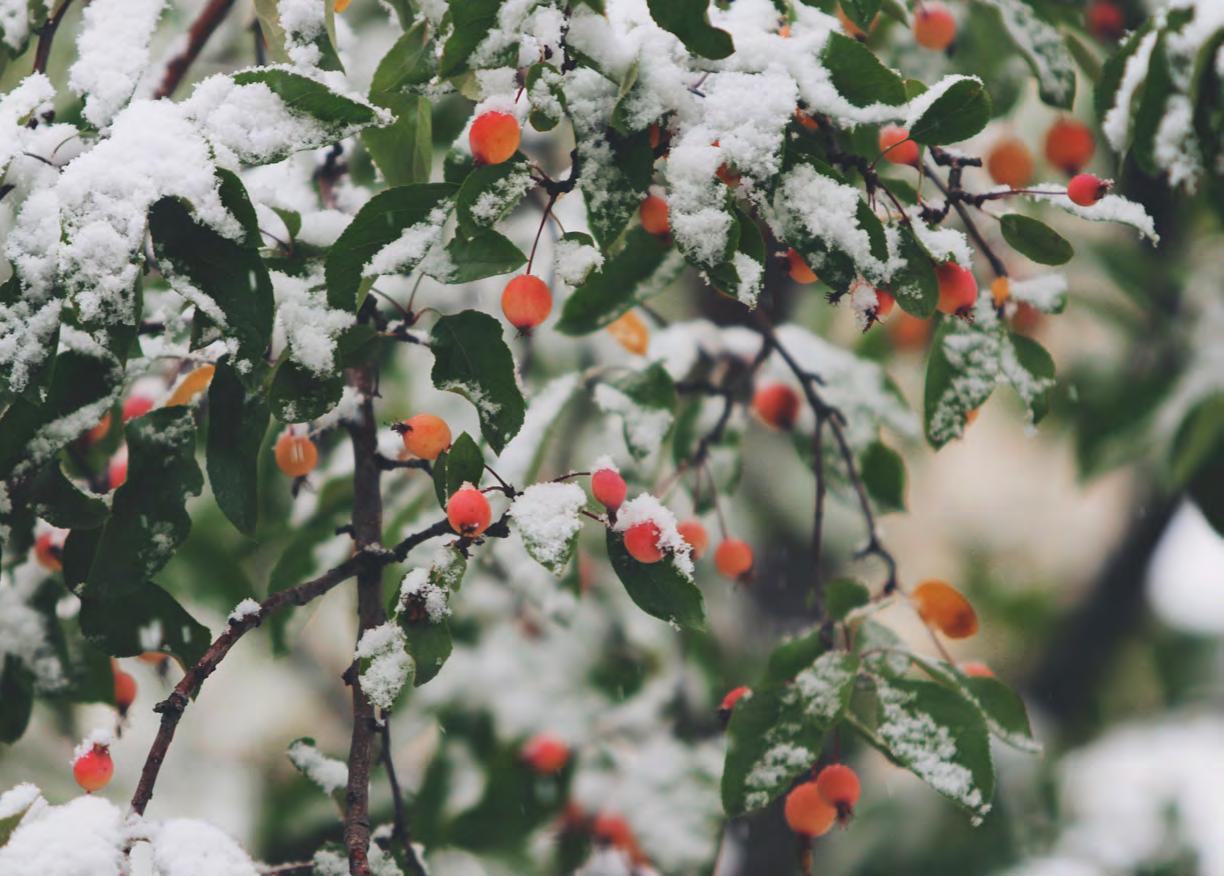
WinteR inteReSt
books in the Weston Family library
By Lee Robbins
Iam very pleased to have taken over the interim librarian position and excited to be associated with such a wonderful and special library and lovely garden. I have loved gardening since my first small pansy garden in the second grade and have been gardening ever since. For my inaugural addition to the winter edition of Trellis, I thought I would highlight a couple of my favourite books about evoking winter interest in our gardens.
Winterland: Create a Beautiful Garden for Every Season
 By Cathy Rees (SB439.5 Ree 2021)
By Cathy Rees (SB439.5 Ree 2021)

In this beautiful but also very practical book, Rees encourages us to think outside the box and to love and engage with our gardens all year round, especially during this sometimes quiet, forgotten season after putting our gardens to bed. Rees demonstrates how the beauty of our natural spaces can continue even in dormant times, gives some key design principles and teaches us to embellish our gardens with texture, colour, structure and ornamentation. Oh, and don’t forget the wildlife! Water is a difficult element to provide for us city dwellers, especially in the ice and snow. Last winter my husband and I purchased a heated birdbath which was most welcomed by our winter visitors, birds and squirrels! Each chapter/section offers useful information on how to highlight different gardening techniques to create rich and compelling winter and year-round enjoyment in our own gardens.
A valuable addition is a list of useful resources (p188) including books, websites and ideas for fun in the snow. Her book is a source of inspiration for making the most of our gardens for year-round enjoyment. I love this book!
Winter Gardens: Reinventing the Season
by Cedric Pollet (SB 439.5 Pol 2021), translated from French.
This is a stunningly beautiful book, full of gorgeous images of winter gardens in France and Britain. More artist than gardener, Pollet showcases the captivating gardens and beautiful examples of how to combine different plant species using basic criteria of form, colour and especially texture. Bark never looked so beautiful! Winner of the UK’s Garden Media Guild - Garden Book of the Year Award and Council on Botanical and Horticultural Libraries Annual Literature Award Nominee, 2018. I can look at his photographs of winter gardens for hours!
Weston Family Library has many more books on winter interest in the garden and gardening for all seasons. Please come visit the library and peruse our collection. I look forward to meeting you.

torontobotanicalgarden.ca 6 Winter 2022/2023
Snowy scene from Winterland by Cathy Rees
 Bark beauty from Winter Gardens by Cedric Pollet
Bark beauty from Winter Gardens by Cedric Pollet


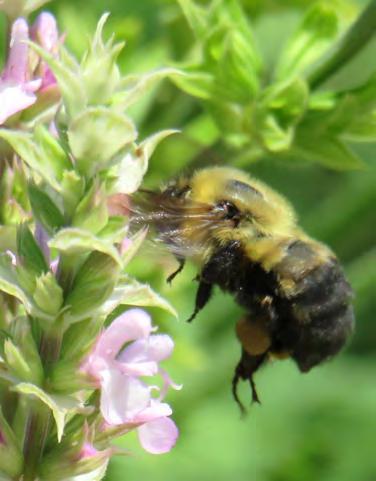




 Ligated Furrow Bee
Little Wood Satyr
Orange Sulphur butterfly
Great Spangled Fritillary Butterfly
Common Blue Butterfly
Silver-spotted Skipper Butterfly
Bumble Bee
Red Admiral Butterfly
Ligated Furrow Bee
Little Wood Satyr
Orange Sulphur butterfly
Great Spangled Fritillary Butterfly
Common Blue Butterfly
Silver-spotted Skipper Butterfly
Bumble Bee
Red Admiral Butterfly
ConneCting with nature
Pollinateto grant helps tbg illustrate the importance of native pollinators and plants


 By Roger Gettig and Sasan Beni Director of HorticultureSeasonal Horticulturist
By Roger Gettig and Sasan Beni Director of HorticultureSeasonal Horticulturist
We’ve been watching the bees, the butterflies, the birds and all the other little pollinators. They’ve been busy as always and visitors would never know, by looking at one of our window boxes, that pollinator populations are dwindling worldwide, running out of habitat and food sources. Here at TBG, we strive to connect our community with nature. We recognize that we have an important role to play, not only in inspiring our visitors, but in acting as stewards of a healthy ecosystem. Needless to say, we have big plans. Unable to contain our excitement, we have shared with the bees, the butterflies and the birds–as they buzz and flutter past–a little about our aspirations and all the ways we intend to help them.
torontobotanicalgarden.ca 9 Winter 2022/2023 Photos: s a san b eni
Eastern Calligrapher
Brown-belted Bumble Bee
Dark Paper wasp
Pollinators Need Our Help

It is part of TBG’s mission to inspire people to live in harmony with nature, and right now pollinators need a lot of help. When we speak of pollinators, we aren’t just talking about birds, bees and butterflies. We also recognize that many moths, flies, beetles, ants and wasps also contribute to the pollination of native trees, shrubs and wildflowers.
Pollinators are critical for healthy ecosystems. Without them, many plant species would not produce the seeds or fruit that many birds, mammals and insects depend on as a source of food. Many of these plants also serve as hosts for the larval (caterpillar) stage of many butterflies and moths. A great diversity of plants requires a great diversity of pollinators to help sustain the resilient ecosystems upon which we depend.
Habitat loss, invasive species, new pests and diseases all combine to make it more difficult for pollinators to maintain their numbers and their important role in our plant communities. Climate change exacerbates all these threats.
Healthy and biodiverse ecosystems have more potential to adapt to a changing climate, making them more resilient. This is highlighted in the Toronto Biodiversity Strategy.
TBG’s Perennial Border is Refurbished to Become a Pollinator Habitat
This year TBG received a PollinateTO grant to transform the Perennial Border into a mixed-border (perennial and woody plant) pollinator garden. PollinateTO supports projects that create pollinator habitat in all Toronto neighbourhoods. Since 2019, PollinateTO has helped create over 300 gardens, resulting in an estimated 22,000 square metres of pollinator habitat.
The goals of this project include creating an accessible garden to better educate our visitors on the importance of native pollinator and plant stewardship.
Requirements of this grant include: • At least 75 per cent of plants must be native perennial species.
• At least one type of native golden rod species must be used. (The new garden provides four: zigzag, stiff, rough and Ohio goldenrods.)
• At least two different types of larval host plants must be used. (TBG examples include milkweed for monarchs and New England aster for pearl crescent and checkerspot butterflies.)
• At least two species in bloom each season from spring to fall, such as eastern columbine and highbush blueberry in spring, swamp milkweed and summer sweet in summer and New England aster and seven son flower in fall.
We started the enhancements in late September so as not to interfere with the aesthetics of this popular wedding spot until the season winds down.We will have a few more additions to the garden next spring.
We hope the transformation of this garden will inspire TBG’s visitors to enhance or create pollinator habitats in their own neighborhoods, gardens or containers.
Plethora of Plants in the Pollinator Garden
S O m E OF th E many woody plants in the tbg ’s new Pollinator g arden are butterfly bush, buttonbush, summersweet, southern bush, honeysuckle, seven son flower, hydrangea, st. John’s wort, Virginia sweetspire, highbush blueberry and arrowwood viburnum.
herbaceous plants include Korean mint, eastern columbine, swamp milkweed, foxglove, Joe Pye weed, heuchera, beebalm, nepeta, penstemon, phlox, salvia, goldenrod, spiderwort and speedwell.
For a more detailed list click here torontobotanicalgarden.ca
torontobotanicalgarden.ca 10 Winter 2022/2023
False milkweed Bug






 monarch Butterfly hemipenthes Fly
White Admiral Butterfly
Eastern Carpenter Bee
Bald-faced hornet
Black Swallowtail
Question mark Butterfly
monarch Butterfly hemipenthes Fly
White Admiral Butterfly
Eastern Carpenter Bee
Bald-faced hornet
Black Swallowtail
Question mark Butterfly
Colour smashing
ball FloraPlant and selecta one trial gardens attract visitors well into fall
By Leanne Burkholder
The Ball FloraPlanT and Selecta One Trial Gardens burst with colour over the summer and into the early autumn months.



The mix of purples, reds, oranges and yellows provided a vibrant backdrop of flowers and foliage to the gardens for visitors, photographers, wedding attendees and…acrobats at the Bloom: Dance & Circus in the Garden presentation.
And, of course, the displays attracted pollinators, with many sightings of various beneficial bees, moths and butterflies such as the monarch.
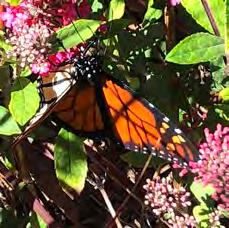

“Every couple of weeks I have visited the trial gardens since May. I loved having the opportunity to speak with members and visitors for their feedback and reactions to the product,” commented Tanya Carvalho, Canada Territory Manager for Ball FloralPlant, Selecta One.

“It was wonderful to see so many people taking photographs in front of the huge petunia beds flanked by the containers Frankie Flowers and I did. People loved the cascade of colour and beautiful backdrop they created for that perfect photo opportunity.”
The coleus raised beds were “an incredible display of how you can use foliage with colour for impact,” she said. “It’s not always about the bloom power!”


Hummingbirds were also very active in the salvia beds, she noted, “and I spoke to many photographers waiting for that perfect shot.”
Planning for the 2023 trial gardens is underway; visitors can expect some gorgeous new pollinator plants including a plum/burgundy salvia, a rich red angelonia and some exciting new lantana colours!

torontobotanicalgarden.ca 12 Winter 2022/2023
l
b
Photos:
eanne
urkholder
1 2 3 4 5 6 7 8
Containers designed by Tanya Carvalho and Frankie Flowers flank large petunia beds.
 Roman Red Salvia and Lantana Shamrock Rose.
1. Dahlia Venti Mango 2. Coleus Habanero 3. Coleus Burgundy Wedding Train 4. Lantana Shamrock Rose 5. Salvia Black and Bloom 6. Thunbergia Sunny Yellow 7. Monarch Butterfly 8. Salvia Blue Chill
Roman Red Salvia and Lantana Shamrock Rose.
1. Dahlia Venti Mango 2. Coleus Habanero 3. Coleus Burgundy Wedding Train 4. Lantana Shamrock Rose 5. Salvia Black and Bloom 6. Thunbergia Sunny Yellow 7. Monarch Butterfly 8. Salvia Blue Chill
is it good or bad for your garden? consider the pros and cons.
 By Carol Gardner
By Carol Gardner
Grass Fake
torontobotanicalgarden.ca 14 Winter 2022/2023 Photos: l orraine h unter, (this P age) Pexels
a
n increasing number of home gardens are starting to rely on artificial grass. Whether that’s a positive thing depends on who you ask.

Artificial turf is certainly not a new thing; in 1966, it was installed in the Astrodome. It was developed by Monsanto (but is no longer owned by them) and called Chemgrass before it was rebranded as Astroturf. It was developed for sports fields, however, in the past few years its use has spread from sports fields to school yards, fancy hotel gardens and
commercial and residential properties. Even Casa Loma – gasp - has artificial grass. The product has gone through three major iterations or “generations”:
First Generation
Astroturf consisted of short-pile synthetic fibres, some of which were quite abrasive to athletes, causing some sports arenas to return to natural grass.

seCond Generation
Longer fibres and sand infills were less abrasive and better looking than their predecessors.
Artifici A l
Turf
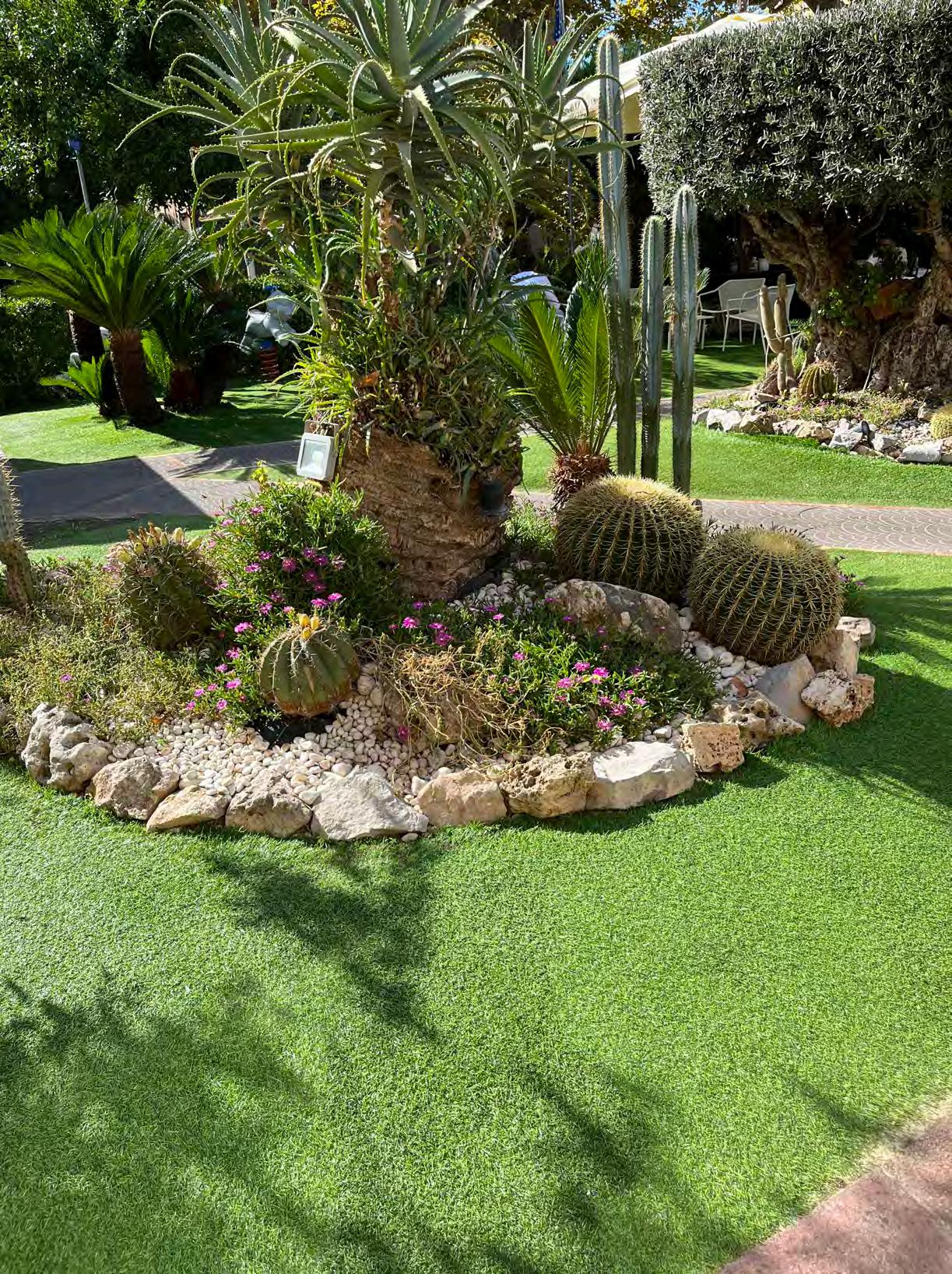
third Generation
(mostly used today) – Composed of infills made of sand and granules of recycled rubber or ‘rubber crumb’. Everyone involved seems to agree that the third generation of artificial grass is a great improvement over previous versions.
In 2015, Toronto Public Health convened a committee (Health Impact Assessment of the Use of Artificial Turf in Toronto) on the subject, focusing on the third generation of artificial grass. Members came from Health, Water, City Planning, Forest & Recreation and the Environment and Energy Division. They acknowledged that, as well as its use for Toronto sports fields and recreation projects, a large number of schools were using artificial grass. The results of that study are the ones I’m using. Let’s have a look at the claims of the manufacturers/installers of artificial grass in relation to this study:
extreme weather events and increase adverse health impacts associated with these events… It can create a ‘heat island’ effect.”
5 it saves on water. True. However, it does increase the possibility of localized flooding during ‘extreme weather events.’
6 The use of the product for pets is one of its big advantages. Grass requires fertilizers and chemicals that could be dangerous to pets whereas artificial turf is safe for them. Moreover, pet waste will damage a lawn, whereas artificial turf is resistant to this problem as it has drainage and its anti-microbial bacteria properties mean that bacteria won’t linger and cause odours. Mind you, either way, you still have to pick up the stuff! However, if emitting an odour, artificial grass can be cleaned with a spray of water and vinegar and a good hosing.
1
artificial grass is easier to maintain, especially for older or disabled homeowners who would find it difficult to deal with a lawn. Can’t argue with that one. Artificial grass doesn’t need to be watered, mowed or weeded.

2 it saves you money because you aren’t spending on fertilizers, chemicals and lawn equipment. That’s debatable. The product can last up to 15 years, but it’s far from cheap. The average price comes to about $12 to $13 per square foot, although prices vary widely due to the quality of the product.
3
i t’s allergy free. Here’s where some beg to differ. According to the Toronto document: “There is insufficient evidence related to the allergenic potential of latex in crumb rubber; more study is required to address uncertainty in exposure estimates for lead, other metals, polyaromatic hydrocarbons and other substances; and further research is needed to more fully understand the potential impact of low-level exposure to carbon nanotubes. These risks can be minimized through the use of standard hygienic practices.”
4 artificial grass can become extremely hot. This is agreed upon by pretty much everyone, however the manufacturers say that spraying it with cold water or wearing shoes or sitting on blankets can mitigate the effect. With climate change, this is one of the top concerns for the environment. “Overall the main concerns relating to the use of artificial turf are linked to climate change mitigation and adaptation. Widespread use of the product would make Toronto less resilient to
The City document also reminds us that “natural surfaces are important features of an urban landscape. They provide valuable environmental services by helping to cool the air, absorb rainwater and remove carbon dioxide from the atmosphere.”
There is no shortage of scholarly articles on artificial grass – pro or con. I’m afraid that this is going to be one of those things that ‘experts’ will argue about forever, or at least until something newer comes along. As for me, I like the option of pulling up natural grass and replacing it with perennials. Before you make a decision one way or the other, know that, in Toronto, artificial grass is considered ‘hardscaping’ and the City limits how much hardscaping you can have in a given space. So check the zoning bylaws in your area before doing anything. Trying to find that information will take years of phone calls, emails, and internet searches and could allow you to postpone the decision forever.
torontobotanicalgarden.ca 17 Winter 2022/2023 Photo: l orraine h unter
“in toronto, artificial grass is considered ‘hardscaping’ and the City limits how much hardscaping you can have in a given space. so check the zoning bylaws in your area before doing anything. ”

torontobotanicalgarden.ca 18 Winter 2022/2023
Montreal Botanical Garden/ Jardin Botanique
connecting with the past at North America’s largest First Nations Garden
 By Veronica Sliva
By Veronica Sliva
Designated as a National Historic Site in 2008, the Montreal Botanical Garden is one of the world’s leading botanical gardens with what is by far the most complete plant collection in North America. Covering 75 hectares with 10 exhibition greenhouses and 30 themed outdoor gardens, you can’t see it all in an afternoon (though I have tried)! Not to be missed is the First Nations Garden. Depicting the natural environment that
Three Sisters Demonstration Garden
 The Interpretation Pavilion houses the ‘Knowledge and Know-How Exhibition’
The Interpretation Pavilion houses the ‘Knowledge and Know-How Exhibition’
Historical significance
AuGuST 4, 2021, marked 20 years since the First Nations Garden was inaugurated. That day coincided with the 300th anniversary of the Great Peace of Montreal of 1701 when 39 Native Nations and the French people agreed to end years of warfare. Today, the garden exists “in a spirit of sharing and respect for differences,” says Florent Vollant, an Innu singer-songwriter who serves as the First Nations Garden’s spokesperson. Canada is still working through a new era of reconciliation, and within this context, the garden can offer a physical acknowledgment of history while keeping traditions alive. “To pay tribute to this relationship between the First Nations and the plant world in a botanical garden, we had to represent the complex world of plants as it exists in nature. We weren’t interested in creating the type of garden where plants are grouped together only according to use or appearance.”
was home to the 11 First Nations of Quebec, at 25,000 square metres, it is the largest of its kind in North America. Entry to the garden is low-key with a path bordered by a cool and tranquil forest. Unlike the Chinese and Japanese gardens, there are no crowds. What you will find is a cacophony of birdsong and the sweet fragrance of layers of forest plants. It’s easy to gear down and simply enjoy the peace and quiet, but you’ll probably learn a thing or two as well.
Knowledge and Know-How Exhibition
Start your journey through the curving roof of the Interpretation Pavilion where the ‘Knowledge and KnowHow’ exhibition introduces you to artifacts created by Native artists and master craftspeople. Here you can view objects from times past, such as ash splint baskets, tools crafted from caribou antlers, a birchbark canoe, even a baby carrier called a “tikinagan” and much more. You can also watch
short videos produced by young people from Native communities in Quebec and other parts of Canada depicting First Nations culture.
The Ecosystems of the Garden
Though the First Nations Garden opened in 2001, the site was previously known as the Ecological Groups. Planted in the late 1930s with trees typical to Quebec’s forested areas, these trees, now mature, form the framework for the garden.
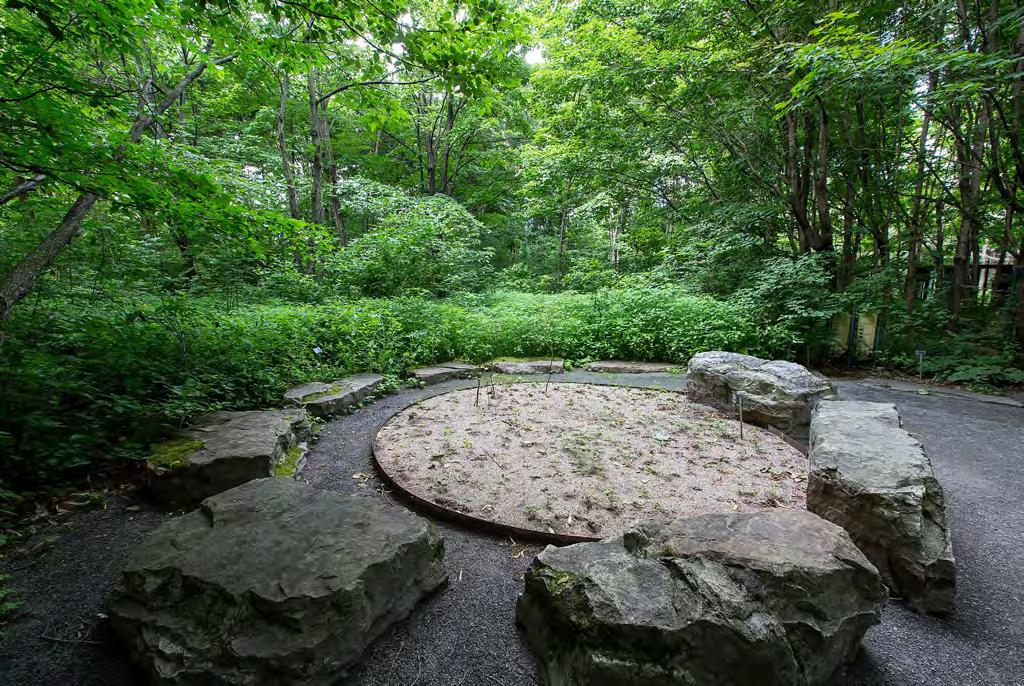
torontobotanicalgarden.ca 21 Winter 2022/2023 Photos: Veronica s li V a ( oPP o site), Montreal b o tanical g arden (this P age and P re V ious P age)
Storytelling area



 Softwood forest
Softwood forest
P H oto: Montreal Botanical g arden ( t o P )
Entering the Interpretation Pavilion
The space is organized into the different ecosystems that were present when First Nations people occupied the lands.

The Hardwood Forest Zone
Dominated by sugar maples and oaks, this zone is located in the centre of the garden where foot traffic is relatively low, making it an ideal home for wildlife. Blackberries, raspberries and wild herbs such as wild ginger and toothwort grow in the understory.


Among the hardwood trees, the Three Sisters demonstration plot depicts Indigenous growing methods involving planting corn with a ground cover of squash and beans to grow up the corn stocks. Corn is estimated to have been introduced 3,000 years ago, accounting for up to 65 per cent of the Iroquois diet during some peri-
ods of history. I learned that according to Iroquois mythology corn first sprang from the breasts of a woman lying in her grave!
The Softwood Forest Zone
Besides coniferous pine, spruce and balsam fir trees, here you also find deciduous birch trees. A variety of other plants make the forest floor their home, too. For example, the oval aromatic leaves of trailing arbutus (Epigaea repens) form a lowgrowing carpet among the pines. In springtime, their white to pale pink trumpet-shaped flowers release a lovely fragrance that is followed by a whitish berry. They share the forest floor with ground lichen and sphagnum moss. Because of their absorbent properties, the Inuit and the Algonquin people used these plants for diapers and toilet paper. The Atikamekw used sphagnum in compresses to treat illness, and the Cree used it between
the logs as mortar when building their cabins. As you explore the conifer forest’s paths, you will find a wigwam tent covered in birch bark.
The Peat Bog
Some plants used by our First Nations people grow only in the moist, acidic and low nutrient environments of a peat bog. Creating this kind of environment was challenging for the garden’s planners, so they turned to technology developed by the peat industry. First, they dug a pond, lined it with a waterproof geotextile membrane and then filled it three-quarters full with a substrate composed of 5 parts peat moss to 1 part coarse sand. The pond was filled with water with an acidity level comparable to that in Quebec’s peat bogs. A layer of sphagnum moss harvested from a managed peat bog near Rivièredu-Loup topped the pond. Bog plants such as Kalmia (Kalmia polifolia and angustifolia), the carnivorous pitcher
torontobotanicalgarden.ca 23 Winter 2022/2023
Photos: Veronica s li V a ( oPP o site b o tto M this P age and next P age)
Wigwam tent is covered in birch bark
Purple flowering raspberry
Red baneberry
plant (Sarracenia purpurea), and cranberries (Vaccinium macrocarpon and V. xycoccos) were planted and have now colonized along with others.
Nordic Zone
This black spruce forest represents the cold, subarctic region that lies between the tundra on a base of rock covered with sparse vegetation. Here among the dwarfed black spruce trees, the land is dominated by shrubs and grasses. Inuit people used cottongrass (Eriophorum) found in this environment as wicks for oil lamps.
Dotting the landscape, structures called Inukshuks, made of stones piled on top of one another, take on a human-looking form. In the snow-covered north where everything can look the same, these Inukshuks were used for navigation as well as to mark sacred places. Inuit hunters created paths with Inukshuks lining both sides. They hid behind them as the women chased the caribou down and into the waiting hunters’ bows and arrows.
This wonderful First Nations Garden gives visitors the chance to rediscover the cultures of North America’s first inhabitants and showcases their wisdom and traditions as well as how First Nations activities are related to the plant world.
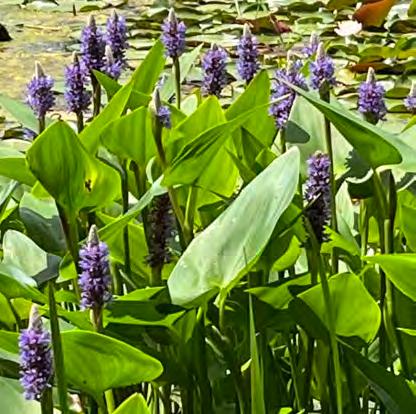
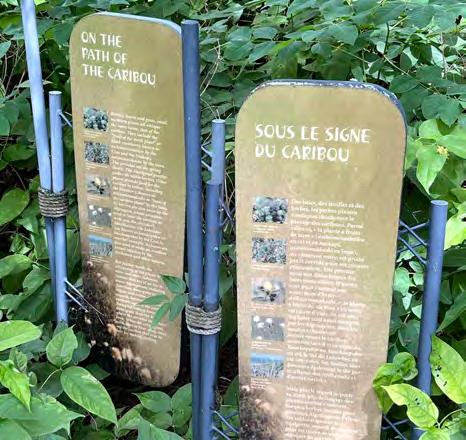
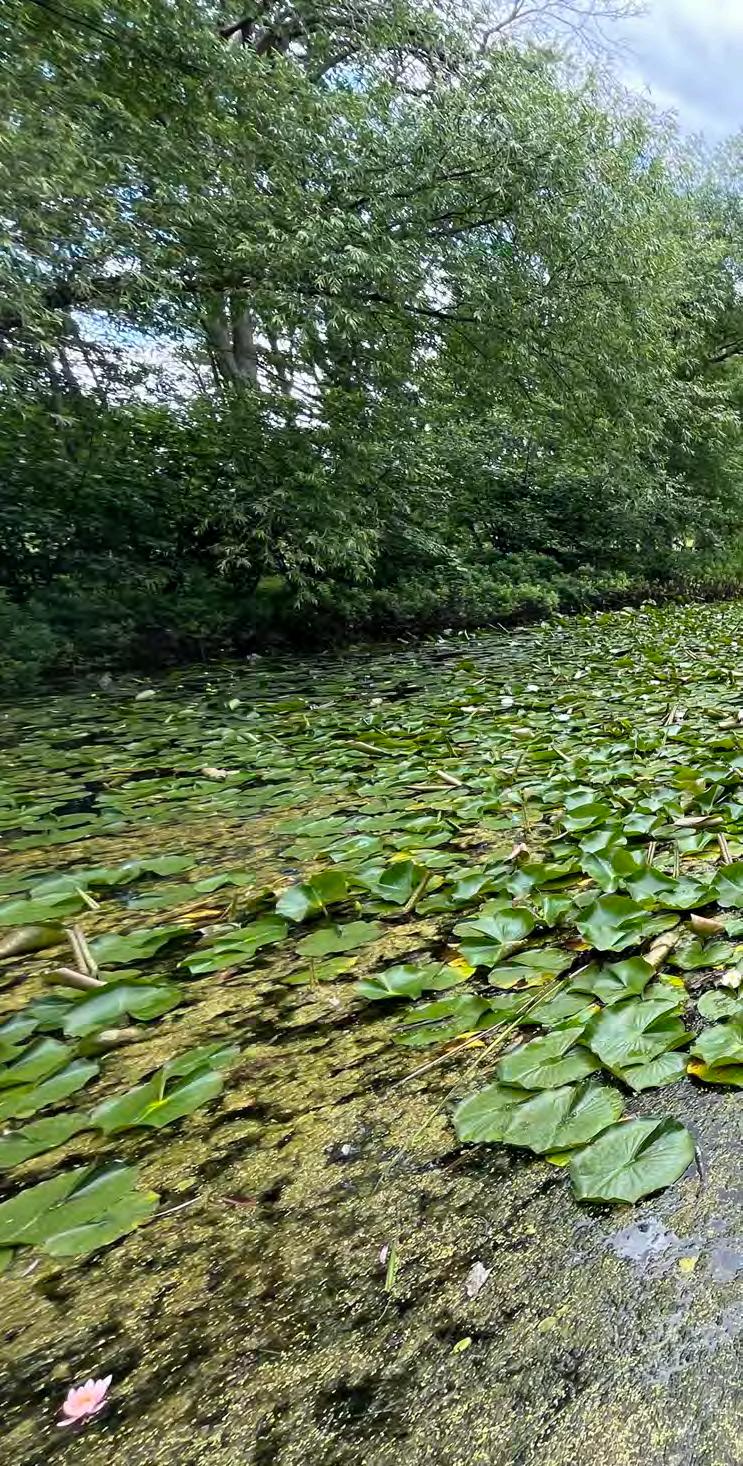
torontobotanicalgarden.ca 24 Winter 2022/2023
Pickerel weed
Jardin Botanique | espace Pour la Vie espacepourlavie.ca/en/Botanical-garden
Some plants used by First Nations people grow only in peat bog conditions.

torontobotanicalgarden.ca 25 Winter 2022/2023
Vallarta Botanical garden



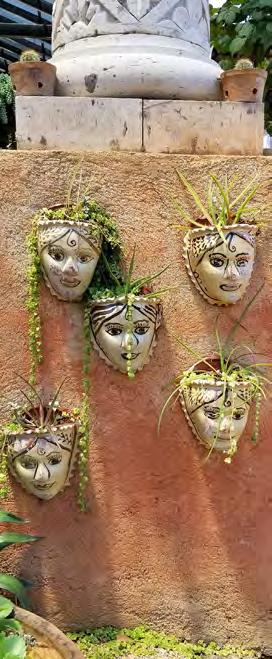


 Clockwise from Top Left: Exotic Medinilla, Ancient Faces, Vanilla vine on a post, Vireya Rhododendron, Friendly Skull, Succulent Collection, Cacao Pods
Clockwise from Top Left: Exotic Medinilla, Ancient Faces, Vanilla vine on a post, Vireya Rhododendron, Friendly Skull, Succulent Collection, Cacao Pods
to most of us, the word ‘Mexico’ means beach resorts like Cancun and Puerto Vallarta. Yet there are many sides to this colourful, unpredictable and sometimes scary country – and here’s one that is rarely discovered by foreign visitors.
Mexico is quite simply a paradise if you’re a gardener. It’s the place to see amaryllis and clivia overflowing from flowerbeds in people’s gardens, poinsettias the size of whacking great shrubs, rare species of cacti clinging to roadsides and so many spectacular flowering trees – like jacaranda, poinciana and Copa de Oro – they can literally take your breath away.
The sheer range of plant life in Mexico is extraordinary (and was a surprise to me, given the clichéd emphasis on sun, sand and sea in their tourism advertising) and there’s a whole lot of it to explore at the Vallarta Botanical Garden. This blissful escape from the jampacked tourist hang-outs on the Pacific coast was started by an American plant lover, Bob Price, who, some years ago, bravely bought up 30 or so hectares of jungle outside Puerto Vallarta with his own money, determined to create a showcase for the country’s natural beauty. And
A blissful escape from the jampacked tourist hangouts
By Sonia Day
he’s certainly succeeded – aided by donations, a few committed staff and a squad of equally dedicated volunteers.
This past summer, the Vallarta entry won the Garden Excellence Award for 2022 from the American Public Gardens Association. It’s the first time any such garden outside the U.S. has won – and it beat out over 600 other gardens to get there.

So what makes this little piece of paradise so special? I’ve been there twice and could go on and on about its charms: the vivid colours and delicate shapes in the huge collection of Vireyas, the tropical kind of rhododendrons; the magnificent magnolias and orchids (the garden is managing to save many endangered species); the vanilla plantation and cacao trees; the peaceful forest of soaring tropical hardwoods that I strolled through; the artistically arranged collection of succulents in terracotta pots; the restaurant with
colourful Mexican tablecloths, where drinking straws are made from bamboo and the food is surprisingly good.
But what sticks in my mind the most is following a gentle path down to a pool created by a river gushing from a mountainside–then ducking behind some rocks to pull on my swimsuit. It was a hot, sticky day and taking a dip in that clear, cool water–as yet unpolluted by human beings–felt heavenly.
There can’t be many botanical gardens in the world where you are permitted to do such a thing.
So if you’re heading for a beach holiday in Puerto Vallarta or its environs this winter, skip the swimming pool and margaritas for a day and head out to this garden. It’s easy to reach (and costs only a few pesos) by a public bus marked El Tuito, which leaves from outside Puerto Vallarta’s Public Market several times a day. The bus winds along the coast, offering some great views, then drops you right outside the garden gates. Some hotels also arrange tours.
And who knows? Perhaps I’ll see you walking in that hardwood forest. I’m dying to go back.
The Vallarta Botanical Garden (vbgardens.org) plays a role in Sonia’s new novel, The Mexico Lunch Party, about a group of women gardeners who meet up in Mexico. Available on Amazon.
Photos: Ann h uber
torontobotA nic A lg A rden.c A 27 Winter 2022/2023
Award winning entrance to Vallarta Botanical Garden
Giverny

as close to a magical garden as you will ever see
By Carol Gardner
impressionist artist Claude Monet (1840-1926) had two passions: painting and gardening (three if you count women). Those passions fed upon one another, and his comfortable house and two and a half acres of land, in the charming village of Giverny in normandy, France, allowed him to indulge both. Over time, he designed a series of flower gardens radiating out from the house with a grand allée in the centre, as well as a magnificent more natural area with a Japanese bridge (which he insisted on painting himself), trees, shrubs and flowers, surrounding a curvilinear pond of water lilies.
torontobotanicalgarden.ca 28 Winter 2022/2023
c arol g ardner
Photos:
Monet’s lily pond.
Monet had his first exhibition, featuring a painting– Impression Sunrise–that, many years later, would give birth to the name of his style dubbed Impressionism
 Claude Monet’s study.
Claude Monet’s study.
 Sunny kitchen in Monet’s house.
Sunny kitchen in Monet’s house.
The two main areas of the garden each have a different atmosphere. The flower garden bursts with a magnificent collage of colours, sizes and shapes, while the pond area is moody and ethereal. Both appear to have a profound effect on visitors, who seem boisterous in the flower garden, but much more subdued in the more tranquil area. it’s a small lesson in how environment shapes mood, and how it also shaped the artist’s work.
Monet was fascinated with the effect of light on a scene, a fascination that you can see in all his paintings of Giverny, particularly his many portraits of the water lilies that he adored. He credited his appreciation of light to his time spent in the military in Algeria.
For 50 years after his death, at 86, Monet’s house and garden languished. in 1977, Giverny was taken over by the Claude Monet Foundation. it took three years of repair and refurbishment to return it more or less to the state we see today. They now receive over half a million tourists yearly, bringing in enough money to keep it going in fine fettle.
When you visit, you don’t see gardeners doing maintenance, so it seems like a horticultural fantasy that fell into place haphazardly, if beautifully. nothing could be farther from the truth. in Monet’s day, six gardeners as well as some family members helped maintain the garden. now, it is main-


torontobotanicalgarden.ca 31 Winter 2022/2023
In 1883, Monet’s increasing wealth allowed him to rent a house in Giverny, which he eventually was able to buy.
Monet’s flower garden bursts with colours, sizes and shapes.
Pathway to Monet’s house.
In the end, he called the garden his greatest masterpiece.
tained by a head gardener and at least eight sub-gardeners, who must keep very busy: just skimming the pond takes two hours daily. The pond skimming had its beginning with Monet himself, who insisted the water lilies be pristine before he painted them.

Since the Monet Foundation took over, there had been one head gardener: Gilbert vahé. When he retired in 2011, he was replaced by an english gardener, James Priest. Priest was there for six years, until 2017, but it was not a love match. Firstly, to have an english gardener take over France’s most famous garden struck some as unseemly. Moreover, some thought he was changing the garden to resemble english style. Sacré bleu! When he left, he more or less disappeared from view, with the Foundation refusing to comment. Dare i say that i was there during his ‘reign’ and i thought the garden was much better maintained than it was on a visit this past summer? At any rate, Gilbert vahé was brought back from retirement to return the gardens to its roots. He has now been replaced by Jean-Marie Avisard, a gardener from normandy, of whom vahé approves. Of the changes made by James Priest, vahé sniffed, “he made it look like a town garden.”

if you haven’t been to Giverny, make a plan. it’s as close to a magical garden as you will likely ever see…and the world seems a little short of magic at the moment.
Monet the Man
Claude Monet was drawn to art at an early age. nevertheless, as an adult, he was far from an instant success. his father, a Paris-born grocer, thought that being an artist was a non-starter in terms of making a living and, for quite a while, he was right.
after a stint of conscription in algeria, Monet was painting and living with his model and muse, camille they lived in penury, usually just one step ahead (or behind) their creditors, because the art cognoscenti of the time rejected his style. he even attempted suicide once by throwing himself into the seine he married camille in 1870 and, two years later, Monet had his first exhibition, featuring a painting–impression sunrise–that, many years later, would give birth to the name of his style, dubbed impressionism. his star began to rise, slowly.
eventually, in 1883, Monet’s increasing wealth allowed him to rent a house in giverny, which he eventually was able to buy. sadly, camille had died of cancer six years earlier, shortly after giving birth to their second son. she was never able to enjoy his success or the wonders of giverny. his second wife, alice, who had been his mistress while camille was dying, was apparently so consumed with jealousy of the late camille that her enjoyment of life was affected. it seems that even geniuses have their domestic issues.
Monet died in 1926, at the age of 86, at his beloved giverny. in the end, he called the garden his greatest masterpiece. the unhappy alice had died 15 years earlier, so perhaps the artist had had a few tranquil years. cg
torontobotanicalgarden.ca 32 Winter 2022/2023
Photo: Paul g ardner
Another view of Monet’s pond.
 Dahlias in Claude Monet’s garden.
Dahlias in Claude Monet’s garden.
For the Bi rds
After all the migrants have left for warmer climates, one of my greatest pleasures is creating and sharing a backyard environment where our resident birds keep returning throughout the winter. Providing nutritious food, water and shelter is the recipe for success, with a few changes to the summer routine to combat the cold and ice.
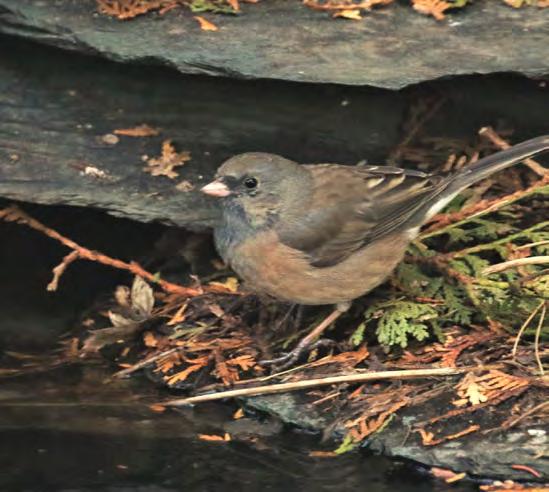

Yes, there are pros and cons about backyard feeders. The negatives focus on how birds congregate at feeders and can allow the spread of disease through their proximity and droppings. Regular cleaning of the feeders and the ground
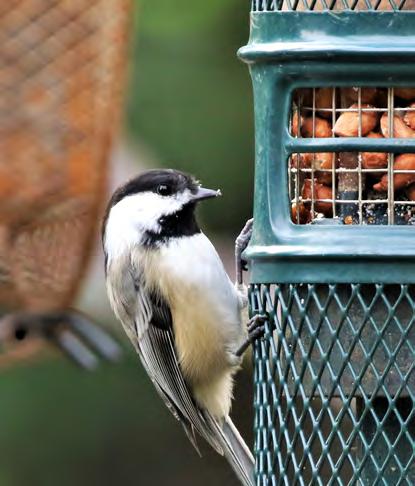
below is the best way to prevent this. Recent outbreaks of avian flu gave the critics another reason to discourage feeders, but studies by the Cornell Lab of Ornithology support that only those with domestic poultry are likely to be concerned, since songbirds are generally not affected by the disease.
Providing a variety of feeders, designed to deliver niger seed (for finches), peanuts or suet (for blue jays, woodpeckers, and Carolina wrens), and black-oil sunflower seeds, both shelled and regular (for cardinals, sparrows, chickadees and nuthatches) will attract a greater variety of species, and prevent

the visitors from fighting for a spot at the feeder. We don’t offer bread since it isn’t considered beneficial for songbirds. It provides poor nutrition, can spoil and go mouldy, and thus create serious health hazards for birds.
A squirrel-resistant pole with hangers for several different feeders is situated in the centre of our yard, far enough from trees and structures so that squirrels and other pests have a hard time accessing them. For Mourning doves and other birds that prefer ground feeding we set up a raised tray feeder so they don’t have to battle ice and snow.
torontobotanicalgarden.ca 34 Winter 2022/2023
Photos: Walter s liva
Providing a feeding station keeps us connected to the garden when plants are asleep
By Walter Sliva
Shelter is an often-overlooked aspect of a bird feeding station. Don’t rush to clear out your dead and dried-out garden foliage and fallen branches. Besides retaining moisture and providing natural fertilizer, this vegetation provides a home for invertebrates (food for many other species) and shelter during the cold and windy months ahead. A brush pile with your cast-off Christmas tree makes a great addition to any backyard.
Small birds at bird feeders may attract hawks and other raptors, so adding multiple layers of shrubbery and trees (both evergreen and deciduous)





will help to provide a safe refuge when the raptors appear.
Bird baths, cleaned and refilled regularly, are magnets for most bird species. We have two heated baths just outside our patio doors, and these are constantly being used for drinking and bathing.
Maintaining a winter-feeding station keeps us involved with our garden even when the flowers and plants are asleep, and helps us smooth the transition from autumn to spring. We get regular winter visits from about a dozen species, with another dozen likely to drop in. We particularly enjoy watching our regulars exchange
their breeding plumage for the drab, winter costumes that have served them throughout the winter. Excitement peaks in early spring when the migrants start arriving, and we realize that winter’s sting is over.
Top l to r: Robin on a heated bath, Chickadee and Nuthatch on a peanut feeder, Dove after a snow storm. Bottom l to r: Downy Woodpecker on a heated bath, Junco beside a frozen pond, Red-bellied Woodpecker on peanut feeder, Eastern Screech Owl hunting below a feeding station
torontobotanicalgarden.ca 35 Winter 2022/2023
a must-have reference book on ground covers

The Complete Book of Ground Covers
4000 Plants that reduce Maintenance, control erosion, and beautify the landscape

Reviewed by Marjorie harris
one waits years for a book like this compendium of ground covers. It’s lovely to breathe a sigh of relief when it arrives and say that The Complete Book of Ground Covers by Gary Lewis will now go to the top of my list of must-have reference books.

Most sane people are getting rid of their lawns and to do a creative job about what’s possible in the world of ground covers this book is ideal. The writing is workmanlike and efficient. No wasting useless time on ghastly garden humour (usually not funny), this is a serious and very sensible tome. What you get is non-stop valuable information: how to use these plants in every possible light/soil condition; visually articulate photographs of plant combinations (perfect for stealing plant combos) and some truly inspiring ideas on designing with plants.
I read just about the whole book including every single entry in the very long and luscious encyclopaedic section describing thousands of plants, without a moment of nodding off. Of course, I concentrated on my own favourites.
Designing with Ground Covers is a chapter worth reading many times over. It really works in the tell-me-something-I-don’t-know part of your brain.
Lewis is a good judge of the characters of the plants he favours with his delighted attention. But he does carry that nurseryman’s disdain for the gardener who fears variegated goutweed in a garden of any size—but flaws like this are few. On the whole, his plant choices are exhilarating: Use clematis and schizophragma (commonly called Japanese hydrangea vine) as ground covers. Nature does it, so of course we should.
The photos are well-placed to enhance the copy, the editing is sometimes annoying (allowing too many word repetitions), but it’s a book you’ll want to dive into again and again with pleasure. The Complete Book of Ground Covers by Gary Lewis (Timber Press).
xxxxx xxxxxxx Book shelf torontobotanicalgarden.ca 36 Winter 2022/2023
Photo:
Marjorie Harris was the gardening columnist for The Globe and Mail. She is now a plant consultant in Toronto. See marjorieharris.com
Erica carnea Schneekuppe, a compact, low-growing evergreen shrub
 Dryopteris marginalis (Marginal shield fern) a woodland fern.
Dryopteris marginalis (Marginal shield fern) a woodland fern.

Festive Drinks to Toast the
3
Season
Sorrel, a drink made from dried hibiscus flowers
Diy
deck the halls with these ornamentini
Sorrel: A J A m A ic A n
cH ri S tm AS d rink
By Georgie Kennedy
With or without rum, this bright red beverage made from the hibiscus flower is a traditional accompaniment to gatherings all over the island. My friend, Jennifer Walcott, shares her own unmeasured recipe.
What you’ll need
• One package of dried sorrel (a type of dried hibiscus) flowers, available at all Caribbean stores and some main stream grocery stores throughout the GTA
• Large piece of fresh ginger, beaten or crushed
• Sugar to taste
• Rum (optional)
Here’s How
In a large pot, cover the sorrel and ginger with water, and then bring it to a boil. Turn off the heat. Cover and leave it to steep for at least three hours.
Strain through a colander Add sugar to taste but do not overly sweeten it.
Treat your guests to the merriest of martinis with this festive twist on the classic cosmopolitan.
What you’ll need
• 1 cup vodka
• 1/2 cup orange liqueur
• 1/2 cup cherry juice
• 1/4 cup cranberry juice
• 1/4 cup orange juice, freshly squeezed with pulp removed
• Frozen cranberries and fresh rosemary sprigs to garnish
• Four 3-inch clear glass ornaments
Here’s How
• Pour all ingredients into a cocktail shaker with ice. S hake vigorously
• Using a funnel, pour the mixture into the glass ornaments that have been rinsed. Replace the topper on each ornament.
• Add frozen cranberries and a rosemary sprig to four martini glasses. Set the ornament in the glass and set them out on display on a tray, bar cart or buffet.

When you’re ready to ring in happy hour, have your guests remove the toppers and slowly pour the contents of the ornament over the frozen cranberries. Keep a bowl nearby to collect the used ornament and toppers… Cheers
Naughty & Nice
If it feels too strong, add water, but don’t make it weak to start. It should be the colour of a good Cabernet or Shiraz! You can add a dash of rum now or when serving.
Store refrigerated in bottles for a few days. Serve cold over ice.
Fair warning. Every Caribbean island uses a different combination of spices and ingredients for flavouring sorrel. We’ve had a longstanding friendly argument about the best method with our Trinidadian and Barbadian relatives. Trinis use cinnamon, cloves and bay leaves. Bajans add an index finger length of orange peel. They boil the sugar with the sorrel and allow it to steep overnight!
Hot Spiced Apple c ider B y Lorraine Hunter
The perfect drink for a holiday gathering, or following an outdoor activity, Hot Spiced Apple Cider is easy to make, tastes good and smells divine.

What you’ll need
• One container of apple cider
• One orange
• Cloves
• Cinnamon sticks
Here’s How
Stick several cloves into an orange. Place the orange into a large pot over low heat. Add cider and a few cinnamon sticks. Simmer for about 20 to 30 minutes. Top with whipped cream if desired. Serve.
Photos: Jenny r hodenizer
By Jenny Rhodenizer Director of Marketing & Communications torontobotanicalgarden.ca 39 Winter 2022/2023
Pieces Puzzle
challenging Puzzles for Patient Puzzlers
Dog Park in Four Seasons
Reviewed by Lila Yorke
This 1,000-piece puzzle is a great choice for those who like a good challenge and love dogs.
While placing the edge pieces first, it appeared as if one was missing until it finally surfaced when the puzzle was almost completed. The easiest way to assemble this puzzle was to sort the tiny pieces by colour and season and then into buildings, trees, people and dogs.

It was a challenge but also a pleasure because Michael Storrings designs are so joyful.
Christian Lacroix Flowers Galaxy

Reviewed by Walter Sliva
This puzzle is cleverly designed with very geometric, repeated patterns making it a daunting organizational challenge at first glance!
The extensive repetition of shapes and colours makes the puzzle look impossible, until you start breaking it into manageable parts. Treat this 500-piece puzzle as a series of separate puzzles–sort the pieces for one picture, construct it, then move on to the next part. Once you identify a similar group of lines or patterns and separate them out, it falls into place rather easily. This puzzle took seven hours to complete.
Around the World in 50 Trees
Reviewed by Walter Sliva
This 1,000-piece jigsaw puzzle by Jonathan Drori and Lucille Clerc is published by Laurence King Publishing. The picture is an amazing collection of commercially important trees from all over the world and includes an interesting and informative poster outlining the significance of each.


I found the subject matter lovely, but the small scale and similarity of many of the scenes made it very difficult to find and locate individual pieces. The pieces did not stay together as well as I would have liked. This meant that it was easy to fit the wrong pieces together and any bumping of the constructed puzzle meant it easily broke apart.
Patient puzzlers will enjoy the challenge but others who like to see quick results may find it a little frustrating.
torontobotanicalgarden.ca 40 Winter 2022/2023
TribuTe TO VOlunTeers
By Sue Hills Head of Volunteer Services and Tour Guides
Not unexpected, but still most appreciated, is the fact that TBG volunteers have consistently donated both their time and talents all year long. TBG volunteers have ensured:

• the delivery of TBG’s regular services (Garden Shop, Weston Family Library)
• the maintenance and care of our beautiful gardens
• the success of every special event
• the opportunity for members of the public and private groups to enjoy a variety of tours that are both educational and engaging. Their talents deployed have been appreciated by all who interact with our volunteers. For the time dedicated to TBG here are some totals (to early September):
ToTal Hours over 7,170
hrs
garden
2,876 hrs (46 volunteers)
Of this total 6,109 come from teams serving shop
2,220 hrs (58 volunteers)
Other active teams contributing this year are
tour guides
190 hrs (27 volunteers)
adult education
127 hrs (11 volunteers)
library
1,013 hrs (36 volunteers)
special events to date
746 hrs (144 volunteers)
and please note these stats do not reflect the unwavering support of volunteers serving on behind the scenes committees and groups, many meeting weekly and include the group responsible for producing this wonderful magazine!
Photo: xxxxx xxxxxxx torontobotanicalgarden.ca 41 Winter 2022/2023
TBG Board member and volunteer
Heygo Tour Guide Abdullah Hamidi giving an online tour.
◗ Natalie Harder has joined the TBG team as Director of Learning. No stranger to the TBG, Natalie worked as Supervisor/Coordinator of the Children’s Program from 2007 to 2015.

In her new role as Director of Learning, Natalie’s focus will be to launch the Toronto Botanical Garden forward as an inspiring and engaging learning environment for visitors and program attendees. She will build on past successes, while diligently focusing on developing programs that are relevant to the Garden’s diverse and evolving audience.
“We specifically recruited Natalie recognizing that she is a self-starter, skilled at balancing the mission and the business; while also motivated to build a team that has the capacity and passion to take the Garden’s learning environment to new heights,” said Stephanie Jutila, TBG Executive Director. “Help me welcome Natalie back to the TBG for the relaunch of our education department, focused on creating a stellar learning environment for our visitors and program attendees.”
Natalie comes to Toronto Botanical Garden following seven years at the Toronto and Region Conservation Authority (TRCA), serving as the Acting Senior Manager/ Supervisor, Education and Training. In this role she led a team running eight distinct programs in York and Durham, along with supervising the Claremont Nature Centre.
Before that Natalie served as Executive Director of the High Park Nature Centre from 2013-2015 and as the Supervisor/Coordinator of Children’s Programs at Toronto Botanical Garden from 2007-2015.
Natalie has a Bachelor of Education from University of Toronto, a Certificate in Fine Art from Sheridan College and a Certificate in Parks and Recreation Management from Schulich Executive Education Centre.
◗ SaNkeetH GaNeSaliNGam has joined TBG as our new Financial Analyst.
Sankeeth’s most recent role was with Youthdale Treatment Centres as Lead Accountant where he was in charge of accounts payable, month-end closing and financial reporting. The organization focused on helping children and their families struggling with mental health issues. Prior to that, he held roles in corporate accounting departments in logistics and manufacturing companies.
Sankeeth graduated from Seneca College with a Bachelor of Commerce and is currently enrolled in the CPA program working towards his designation.

◗ JoSee BertraNd, our new Interim Chief Financial Officer has worked with numerous organizations in the not-for-profit, charitable, private and public company environments in senior financial management roles.
Upon joining The Osborne Group in 2018, she stepped into the Interim Director of Finance position at Crossroads International and then moved on to the Fred Victor Centre

OUR TEAM IS GROW ING
torontobotanicalgarden.ca 42 Winter 2022/2023
Natalie Harder Josee BertraNd
saNkeetH GaNesaliNGam
UR EAM IS ROW ING
as Interim Director of Property Services, to Tennis Canada as Interim Senior Vice President, CFO and to the Rideau Hall Foundation as Interim Director of Finance. Josee also provides part-time CFO support to the St. Joseph’s Health Centre Foundation, providing financial oversight of the Foundation.

Before joining The Osborne Group, Josee worked in senior financial roles with Sunnybrook Health Sciences Centre Foundation and SickKids Foundation. Prior to that, she spent many years in the private and public sectors working in senior financial leadership roles providing oversight and hands-on operational support in accounting, financial management, financial planning and analysis, along with financial reporting. In all of her roles as a senior financial executive, she has had extensive experience working with and reporting to boards and board committees such as audit and finance, investment, risk and governance.
◗ lee roBBiNS has been serving as Interim Library Services Supervisor since August.
With a Master of Science, Library and Information Science, Lee has had a distinguished career in both large and small specialty libraries. Most recently, she was Head Librarian, Department of Astronomy and Astrophysics, University of Toronto, until her retirement in 2021.

“As we continue to build our team, it is important to bring stability and continuity to the library. Lee will guide the library and library volunteers as we work to reactivate our visitors centre throughout the fall and winter,” said TBG Executive Director Stephanie Jutila.
Lee is also an avid gardener and a long-term, passionate volunteer in the Weston Family Library.
◗ aleeSHia CarmaN has joined the team as Grant Writer and Development Co-ordinator. In this new role, Aleeshia’s impact will be to serve the mission of the Toronto Botanical Garden by growing its grant revenues in addition to supporting the stewardship of our donors. She will take the lead on prospecting and cultivation of potential grant funders. As an accomplished storyteller, Aleeshia will help share the relevance, impact and beauty of the TBG, while building a strong case for support.
She has worked as a freelance grant writer for several clients, was an editorial intern for Cottage Life Magazine and worked for the Ontario Public Service supporting program design for the Covid Relief Fund, Residential Risk Assessment and Infection, Prevention and Control Planning, Aleeshia has a Bachelor of Arts from the University of Western Ontario and a Certificate in Professional Writing and Communications, with a focus on grant writing, from Humber College.
torontobotanicalgarden.ca 43 Winter 2022/2023
aleesHia CarmaN
lee roBBiNs
What’s New in the Garden Shop
1. tea lovers will appreciate the flavour and aroma of artisan teas from the tea brewery, a micro-blender located in Mahone bay, nS. the tea brewery’s mission is to create truly exquisite loose-leaf artisan teas that will satisfy today’s most sophisticated consumers.

Good Things Are Happening
2. With these fabric bags, designed by women for women, you can add a personal touch to any outfit, by mixing and matching different panels great quality and lots of room for

essentials. a perfect gift. and don’t forget one for yourself!
3. dandarah hand blown glass ornaments, including these gold Snowflake tealight candle holders, make delightful gifts. each item is designed and handmade in cairo, egypt. – By Terri Dunlop Dewar


torontobotanicalgarden.ca 44 Winter 2022/2023
See TH em A ll in TH e TBG G A rden S H op. 1 2 3
ANNuAl HoliDAy MArket d on’t miss our a nnual Holiday Market which has now grown to a three-day event. You’ll enjoy an eco-minded, nature-inspired, relaxed shopping experience which includes more than 65 local artisans as well as a series of holiday workshops.

the garden Shop will be stocked with a wide selection of holiday home décor, seasonal fresh greens, and poinsettias, along with an Amaryllis potting Bar and a variety of local honey. the TBG Bloom Cafe will be serving up hot beverages and light bites for post and pre-shopping noshing.
Friday, november 25, 2 to 8 p.m.
Saturday, november 26 and
Sunday, november 27, 10 a.m. to 4 p.m
Bloom: Dance & Circus in the Garden “the acrobats were amazing! the garden beautiful as always!” pretty well sums up visitors’ reactions to the September event. Members and guests were treated to a high-flying dance, circus and garden experience. over two matinees and one evening performance 145 people were led through the garden to secret locations to enjoy incredible circus acts including silks, ropes, cube, acrobatic and trapeze artistry.
d eveloped in partnership with the a rtists’ Play, d ance & c ircus Studio, b loom: d ance & c ircus in the g arden was led by a rtistic d irector e lizabeth d awn Snell. the tbg plans to build on this partnership for its 2023 arts and culture programming.


in addition, 86 per cent of the attendees indicated that they visited the garden Shop and/or the bloom café before or after the performance.
tBG Author Series the first event in the tbg authors’ Series this fall was a big hit. over 70 guests, mostly members, turned out to hear former Toronto Star gardening columnist, Sonia day talk about her entertaining new book, The Mexico Lunch Party: a Sisters of the Soil novel. With recipes.
Highlight of the afternoon was capirotada, or Mexican bread Pudding, baked by Sonia herself. “i made four trays of the pudding and it all got eaten,” says Sonia. “everyone loved it.” the dish, traditional in Mexico at easter, plays a role in the book, which is now on sale in the tbg Shop. guests lingered at the end of the event for coffee and conversation, and to purchase some 40 autographed copies of Sonia’s book.
comments from the audience on the presentation included “amusing as well as educational.” and “it was so pleasurable to be with a group of people again. the event was well organized, the speaker so witty and friendly and the Mexican bread pudding was a delicious treat.”

torontobotanicalgarden.ca 45 Winter 2022/2023
Watch for information on the upcoming TBG Indoor WInTer MusIc serIes in the TBG E-News and on the website.
TBG staff members and Bloom performers in the garden.
The Southern Ontario Orchid Society orchId shoW & sale returns to the TBG Saturday and Sunday, February 11 and 12, 2023.

Garden obelisks Make use of vertical space in your garden with a 4 or 6-foot obelisk. Made in toronto exclusively for the toronto botanical g arden, these obelisks are superb structures for showcasing and supporting vines and vegetables. black, powdercoated steel ensures that these towers remain rust-resistant and durable for many years to come. Available throughout the year at the Garden Shop. Available in two sizes: 4 ft $99.99; 6 ft $124.99.

Why our Gardens Matter
lorraine Johnson was the second speaker in the tbg’s Fall authors Series on october 19. lorraine has been writing about gardening as a force for ecological and social change for more than 30 years in books such as Green Future: Tending the Earth; The Ontario Naturalized Garden; Grow Wild; The Real Dirt; City Farmer; 100 Easy-to-Grow Native Plants for Canadian Gardens and the recently published A Garden for the Rusty-Patched Bumblebee (co-authored with Sheila colla.)

lorraine shared stories and readings from her works, looking at what we can learn from efforts to rethink some gardening traditions in order to take us into a future of ecological health and justice and explaining Why our gardens Matter now more than ever.
lorraine was happy to sign copies of her newest book following her talk.

H AL L O F FAME AWAR D LI FE TI ME ACHI E VEMEN T AWAR D TOR ON TO M ASTER GA RD ENE R RE/MAX HALLMARK REALTY LTD., BROKERAGE Direct 416.564.9450 @JoseeCoutureTorontoRealEstate
Sales Representative, ABR, SRES
• classified • P H oto: P H ill P Walli S
WINTER MUSIC SERIES WITH TAFELMUSIK STARTING IN FEB 2023

WHAT'S ON THIS WINTER
MARCH BREAK 2023 NATURE CAMP FOR KIDS
Join us in the Garden this winter for fun and engaging programs for the entire family


torontobotanicalgarden.ca/ events
HOLIDAY HOLIDAY MARKET MARKET

Nov 25-27, 2022
An eco-minded, natureinspired, relaxed shopping experience with over 65 local vendors.
 AUTHOR TALKS, AND PLANT SALES
AUTHOR TALKS, AND PLANT SALES
Plant Profile
PHILODENDRON
A Tale of Two Beauties By Georgie Kennedy
WE MODERN INDOOR gardeners seem to be channeling the energies of the Plant Hunters of Victorian times. Like them, we seek the unusual, the exotic and the rare. We examine in great detail every shoot, every leaf, every bud. We compete to design more and more creative and eye-catching ways to display them. We are the new tropical collectors. Instagram gives us glimpses of homes inspired by Kew, the Palm House in Belfast, or the Kyoto Botanical Gardens in Japan.
Humans have always been fascinated by the green world. Something in our souls senses a mysterious connection. Being near trees and in gardens gives us greater mental and emotional strength. Touching the earth to tend for plants brings healing. One family of plants that has gained great popularity lately is Philodendron. Its Greek name roughly translates to “affectionate for trees” because it clings tightly to trees as it climbs vigorously using aerial roots. Because it is a large genus with many different forms and sizes, I’d like to focus on two brilliant varieties.
Philodendron ‘Pink Princess’ I have the great good fortune to tend a garden part time in sunny Jamaica. I’m drawn to cool shady spaces, so naturally I seek out large-leaved plants. One day about eight or nine years ago, I spotted a crazy beautiful foliage plant at Faith and Hope Nursery in Montego Bay: purple stems holding heart-shaped hot pink, burgundy and bronzy green leaves! I had to take this precious darling home and eventually persuaded the manager to part with it. This vine takes variegation to a new level; the colouration of each leaf is completely unpredictable. A mutation has caused the chlorophyll to be absent in the pink sections. We planted it at the base of a Brasiletto tree (Haematoxylum brasiletto) and just allowed it to wend its way upwards. Although many houseplant guides will tell you it grows to only four feet, in this tropical setting, it’s over 4½ metres (15 feet) already and shows no signs of stopping. It is a slow grower due to reduced chlorophyll.
Philodendron ‘Lemon Lime’

If you’re looking for another leafy plant with Wow! Factor, meet
‘Lemon Lime’. Chartreuse can brighten up any décor. Its leaves are thinner and arrow-shaped. The young leaves emerge bright yellow and as they grow, darken to lime green. Trust me, all your friends will ask for a slip of this sweetheart.
Easy indoor Care
Both varieties need well-drained organic soil. Place them in a location with sufficient light; several hours of bright indirect sky is ideal, and try to avoid south or west windows. A grow light can help ‘Pink Princess’ retain its pink variegation. Always allow the top layer of soil to dry out between waterings. Most indoor plants benefit from a little fertilizer boost during the growing season because potting soil, unlike garden earth, is sterile.
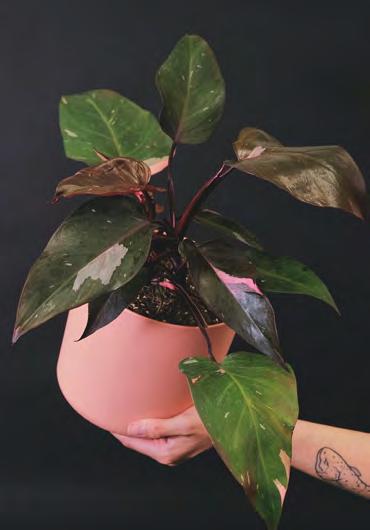
To achieve a bushier appearance, simply trim back. You can use stem cuttings to propagate new plants.
A word of caution: if ingested, the calcium oxalate crystals in all parts of the Philodendron are toxic to humans and pets
Many philodendrons are available at the TBG Garden Shop.

TORONTOBOTANICALGARDEN.CA 48 WINTER 2022/2023
PHOTOS: UNSPLASH, GEORGIE KENNEDY
Pink Princess Lemon Lime
‘Pink Princess’ grown outside in shade is mainly green
BOARD OF DIRECTORS
Board Chair Gordon Ashworth, Vice Chair Tony DiGiovanni, Secretary Dianne Azzarello, Treasurer Janice Winton
Barb Anie, Dianne Azzarello, Adeline Cheng, Doris Chee, Michele Chandler, Ben Cullen, Lisa Ellis, Susan Grundy, Abdullah Hamidi, Harry Jongerden, Nicole Leaper, Margareth Lobo Gault, Helder Marcos, Haig Seferian
Ex Officio: Christina Iacovino (City of Toronto), Derryn Gill (Garden Club of Toronto), Ingrid Smith (Milne House Garden Club).
ABOUT THE TORONTO BOTANICAL GARDEN
The Toronto Botanical Garden (TBG) is a volunteer-based, charitable organization that raises more than 95 per cent of its operating funds through membership, facility rentals, retail operations, program fees and donations. The organization relies on its partnership with the City of Toronto and on the generosity and financial commitment of individuals, foundations and corporations to support the many beneficial services we provide to the community.
OUR MISSION: Toronto Botanical Garden connects people to plants, inspiring us to live in harmony with nature.
OUR VISION: Toronto Botanical Garden will be renowned for its display of nature’s beauty and as a dynamic hub for plant-centred learning, conservation and research.
SIGN UP FOR GARDEN ENEWS!

Receive the latest horticultural news and information on events, workshops, lectures and other horticultural happenings. Free registration at https://torontobotanicalgarden.ca
GENERAL HOURS of ADMISSION
The Garden is open daily from dawn until dusk and admission is free. In-person adult classes, guided garden tours, special events and facility rentals have resumed. Our Visitor Centre, including the Garden Shop, Weston Family Library and public washrooms, is now open daily. The TBG Bloom Café is open daily for light bites and sweet treats. Visit Toronto Master Gardeners at torontomastergardeners.ca
Parking: $2.50 per hour. Members & TBG Volunteers, FREE
DIRECTORY
EXECUTIVE DIRECTOR
Stephanie Jutila sjutila@torontobotanicalgarden.ca
EDUCATION
416-397-1355 education@torontobotanicalgarden.ca
DEVELOPMENT
416-397-1372 development@torontobotanicalgarden.ca
FACILITY RENTALS
416 397-1324 events@torontobotanicalgarden.ca


GARDEN SHOP
416-397-1357 retail@torontobotanicalgarden.ca
GARDENING HELP LINE
Toronto Master Gardeners 416-397-1345 torontomastergardeners.ca
GROUP TOURS
416-397-4145 tourguides@torontobotanicalgarden.ca
HORTICULTURE
416-397-1358 horticulture@torontobotanicalgarden.ca
MARKETING & COMMUNICATIONS
416-397-1351 communication@torontobotanicalgarden.ca
MEMBERSHIP
416-397-1483 annualgiving@torontobotanicalgarden.ca
TRELLIS MAGAZINE editor@torontobotanicalgarden.ca
VOLUNTEER SERVICES
416-397-4145 tourguides@torontobotanicalgarden.ca
WESTON FAMILY LIBRARY
416-397-1343 librarydesk@torontobotanicalgarden.ca
MASTHEAD



EDITOR
LORRAINE HUNTER
DESIGN
JUNE ANDERSON
TRELLIS COMMITTEE
LEANNE BURKHOLDER
SUE HILLS
GEORGIE KENNEDY
JENNY RHODENIZER
VERONICA SLIVA
VOLUNTEER PROOFREADERS
JACKIE CAMPBELL
LYN HICKEY
JEAN MCCLUSKEY
MARG ANNE MORRISON
ROSE ROBERTS
ADVERTISING
416-397-4145
Trellis is published as a members’ newsletter by the Toronto Botanical Garden at Edwards Gardens
777 Lawrence Avenue East, Toronto, Ontario, M3C 1P2, 416-397-1341
Trellis welcomes queries for story ideas, which should be submitted to the editor for consideration by the Trellis Committee at least four months in advance of publication dates.




Opinions expressed in Trellis do not necessarily reflect those of the TBG. Submissions may be edited for style and clarity.
©2022
All rights reserved. Reproduction in whole or in part is prohibited without the written permission of the Toronto Botanical Garden.
Charitable registration number 119227486RR0001
777 Lawrence Avenue East, Toronto Ontario M3C 1P2, Canada • 416-397-1341 fax: 416-397-1354 • info@torontobotanicalgarden.ca torontobotanicalgarden.ca • @TBG_Canada

By TTC: From Eglinton subway station take the 51, 54 or 54A bus to Lawrence Avenue East and Leslie Street. The TBG is on the southwest corner.

TORONTOBOTANICALGARDEN.CA 49 WINTER 2022/2023
Find us on...



NOTHING ELSE IS A HARTLEY The only aluminium Glasshouses and Greenhouses endorsed by the RHS ® The Royal Horticultural Society. The Royal Horticultural Society, and its logo, are trade marks of The Royal Horticultural Society (Registered Charity No 222879/SC038262) and used under licence from RHS Enterprises Limited. Discover the secret of Hartley Botanic by calling 781 933 1993 or visit www.hartley-botanic.com Victorian Villa, Derbyshire,UK









 By Cathy Rees (SB439.5 Ree 2021)
By Cathy Rees (SB439.5 Ree 2021)


 Bark beauty from Winter Gardens by Cedric Pollet
Bark beauty from Winter Gardens by Cedric Pollet







 Ligated Furrow Bee
Little Wood Satyr
Orange Sulphur butterfly
Great Spangled Fritillary Butterfly
Common Blue Butterfly
Silver-spotted Skipper Butterfly
Bumble Bee
Red Admiral Butterfly
Ligated Furrow Bee
Little Wood Satyr
Orange Sulphur butterfly
Great Spangled Fritillary Butterfly
Common Blue Butterfly
Silver-spotted Skipper Butterfly
Bumble Bee
Red Admiral Butterfly


 By Roger Gettig and Sasan Beni Director of HorticultureSeasonal Horticulturist
By Roger Gettig and Sasan Beni Director of HorticultureSeasonal Horticulturist







 monarch Butterfly hemipenthes Fly
White Admiral Butterfly
Eastern Carpenter Bee
Bald-faced hornet
Black Swallowtail
Question mark Butterfly
monarch Butterfly hemipenthes Fly
White Admiral Butterfly
Eastern Carpenter Bee
Bald-faced hornet
Black Swallowtail
Question mark Butterfly









 Roman Red Salvia and Lantana Shamrock Rose.
1. Dahlia Venti Mango 2. Coleus Habanero 3. Coleus Burgundy Wedding Train 4. Lantana Shamrock Rose 5. Salvia Black and Bloom 6. Thunbergia Sunny Yellow 7. Monarch Butterfly 8. Salvia Blue Chill
Roman Red Salvia and Lantana Shamrock Rose.
1. Dahlia Venti Mango 2. Coleus Habanero 3. Coleus Burgundy Wedding Train 4. Lantana Shamrock Rose 5. Salvia Black and Bloom 6. Thunbergia Sunny Yellow 7. Monarch Butterfly 8. Salvia Blue Chill
 By Carol Gardner
By Carol Gardner





 By Veronica Sliva
By Veronica Sliva
 The Interpretation Pavilion houses the ‘Knowledge and Know-How Exhibition’
The Interpretation Pavilion houses the ‘Knowledge and Know-How Exhibition’




 Softwood forest
Softwood forest













 Clockwise from Top Left: Exotic Medinilla, Ancient Faces, Vanilla vine on a post, Vireya Rhododendron, Friendly Skull, Succulent Collection, Cacao Pods
Clockwise from Top Left: Exotic Medinilla, Ancient Faces, Vanilla vine on a post, Vireya Rhododendron, Friendly Skull, Succulent Collection, Cacao Pods


 Claude Monet’s study.
Claude Monet’s study.
 Sunny kitchen in Monet’s house.
Sunny kitchen in Monet’s house.




 Dahlias in Claude Monet’s garden.
Dahlias in Claude Monet’s garden.












 Dryopteris marginalis (Marginal shield fern) a woodland fern.
Dryopteris marginalis (Marginal shield fern) a woodland fern.





























 AUTHOR TALKS, AND PLANT SALES
AUTHOR TALKS, AND PLANT SALES










